Feeling lost in the sea of custom eLearning development solutions?
Do outdated content, lack of engagement, and using eLearning tools that just don’t fit your needs sound familiar?
I get it.
In my time in the training industry, I’ve seen these issues too often. They stand in the way of effective learning and development.
That’s why I decided to write this blog post. I’ll help you with not just finding the best tools but also give you an idea of how to develop custom eLearning content.
| Custom eLearning Development Tools | Best For | Pricing |
|---|---|---|
| ProProfs Training Maker | Employee Training (built-in eLearning Course Authoring Tools) | Forever free for up to 10 learners. Paid plan starts at $1.99/learner/month for large teams. Billed annually. |
| Learning Pool | Creating Adaptive Content | Custom pricing |
| Cornerstone OnDemand | Compliance Management | Custom pricing |
| Docebo | AI-Powered Learning | Custom pricing |
| Tovuti LMS | Learner Experience | Starts at $11,160. Up to 50 users. |
| Open LMS | Flexible Learning | Starts at $1,800 + tax/year. Up to 100 active users. 20GB of storage. |
| iSpring Solutions | Smart Training Management | Starts at $770/author/year. HTML5/SCORM courses. |
| Absorb LMS | Learner Experience | Custom pricing |
| Elucidat | Experienced Authors | Custom pricing |
| Thinkific | Selling Courses | Starts at $36/month. 1 community. 5 spaces per community. |
| 360Learning | Collaborative Learning | Starts at $8/registered user/month. Up to 100 users/month. |
| LearnDash | LMS for WordPress | Starts at $199/year. For 1 site. Includes updates and support. |
Which Custom eLearning Solution Should You Choose?
Selecting the right custom eLearning design tool from a list of 12 can be daunting.
So, I have narrowed down the list further based on my preference.
Here’s why these tools have impressed me the most:
Option A: ProProfs Training Maker:
This tool excels in employee training with its intuitive interface and extensive customization options. The ability to craft engaging courses filled with multimedia elements and interactive activities makes it a standout. ProProfs Training Maker has proven itself to be an invaluable partner in our mission to equip our workforce with essential skills and knowledge.
Option B: Learning Pool:
It shines for its ability to develop adaptive content. The tool uses real-time data and AI to create personalized learning experiences. Its flexibility in content accessibility and the ease of integrating coaching content seamlessly into courses make it a powerful tool for reaching a diverse audience effectively.
Option C: Cornerstone OnDemand:
This platform is best known for its compliance management capabilities. It allows for easy customization of training content and integrates well with learning solutions to streamline the editing, publishing, and managing processes.
Among these, I find ProProfs Training Maker to be the best custom elearning course development tool due to its comprehensive approach to employee training. Its user-friendly interface, customization to match branding, and the ability to hand out certificates upon course completion make it not just a tool but a partner in achieving our training objectives. The significant improvement we’ve witnessed in learning outcomes and overall training ROI cement its place as my top recommendation.
What Is Custom eLearning Development?
“Custom eLearning is not a one-size-fits-all solution, but rather a strategic approach to creating learning experiences that are effective and efficient.” – Karla Sharpe.
Custom eLearning development is the process of creating bespoke online learning experiences tailored to the specific needs of an individual or organization.
This can include anything from developing new courses from scratch to adapting existing content to fit specific requirements.
Mostly, it is done using rapid authoring tools by offering drag-and-drop interfaces, pre-built templates, and interactive elements, allowing faster course creation without extensive coding knowledge.
12 Best Custom eLearning Service Providers
Here are some of the best custom eLearning development tools you can try out for your business.
I have created this list based on personal experience, and some of the tools I have mentioned below are a result of my extensive research and peer recommendations.
1. ProProfs Training Maker – Best for Easy Online Employee Training & LMS (Built-in eLearning Course Authoring Tools)
For years, we have been searching for the perfect custom elearning development services to elevate our employee training programs. After exploring various options, we came across ProProfs Training Maker. This tool ticked all the boxes for us.
Their team of expert instructional designers took the time to understand our unique needs and learning objectives. They crafted engaging courses packed with multimedia elements and interactive activities. This ensured our learners retain information effectively. The mobile-friendly format allows learning on any device, which further enhances accessibility and flexibility.
The LMS platform simplifies course management to provide valuable insights into learner progress through its powerful reports. This empowers us to refine our training materials and ensure they deliver the desired results.
With this tool, we’ve witnessed a significant improvement in learning outcomes, employee satisfaction, and overall training ROI. They’ve become an invaluable partner in our quest to equip our workforce with the skills and knowledge needed to excel.
Best part?
We have now started using the tool independently. Their help section is truly helpful, and we are now using this tool for all our training needs.
What You Will Like:
- The interface is easy to use
- Enables easy customization to match branding
- Virtual classroom to centralize all learning activities
- 100+ course settings to choose from
- Hand out certificates after course completion
What You May Not Like:
- The free plan is limited to just up to 10 learners
- It would be great if they could add a few more course templates
Pricing:
Forever free (for up to 10 learners). Paid plan starts at $1.99/learner/month for large teams. No hidden charges. 15-day money-back guarantee.
2. Learning Pool – Best for Creating Adaptive Content

Our organization has found the Learning Pool to be a good choice for developing adaptive content. The features have significantly streamlined our eLearning material creation and editing processes.
For instance, the ability to easily duplicate layers within the Learning Pool editor has simplified our design workflow.
When publishing courses, Learning Pool’s flexibility to select the desired SCORM version ensured that our content was accessible and compatible across various platforms. This adaptability was crucial for us to reach our diverse audience effectively.
The automatic scrolling feature when moving sections and blocks made rearranging content far more efficient. I really admire the Fast Track Progression feature and the new Slide Location called Topic Materials, as it offered us greater control over course navigation and the ability to integrate coaching content smoothly.
What You Will Like:
- Uses real-time data and AI to create personalized learning experiences
- Offers a wide range of courses
- Have a library of ready-made content that can be tailored to suit different contexts
What You May Not Like:
- Can be complex and overwhelming for some users
- Has limited customization options
Pricing:
Custom pricing
3. Cornerstone On Demand – Best for Very Large Enterprises
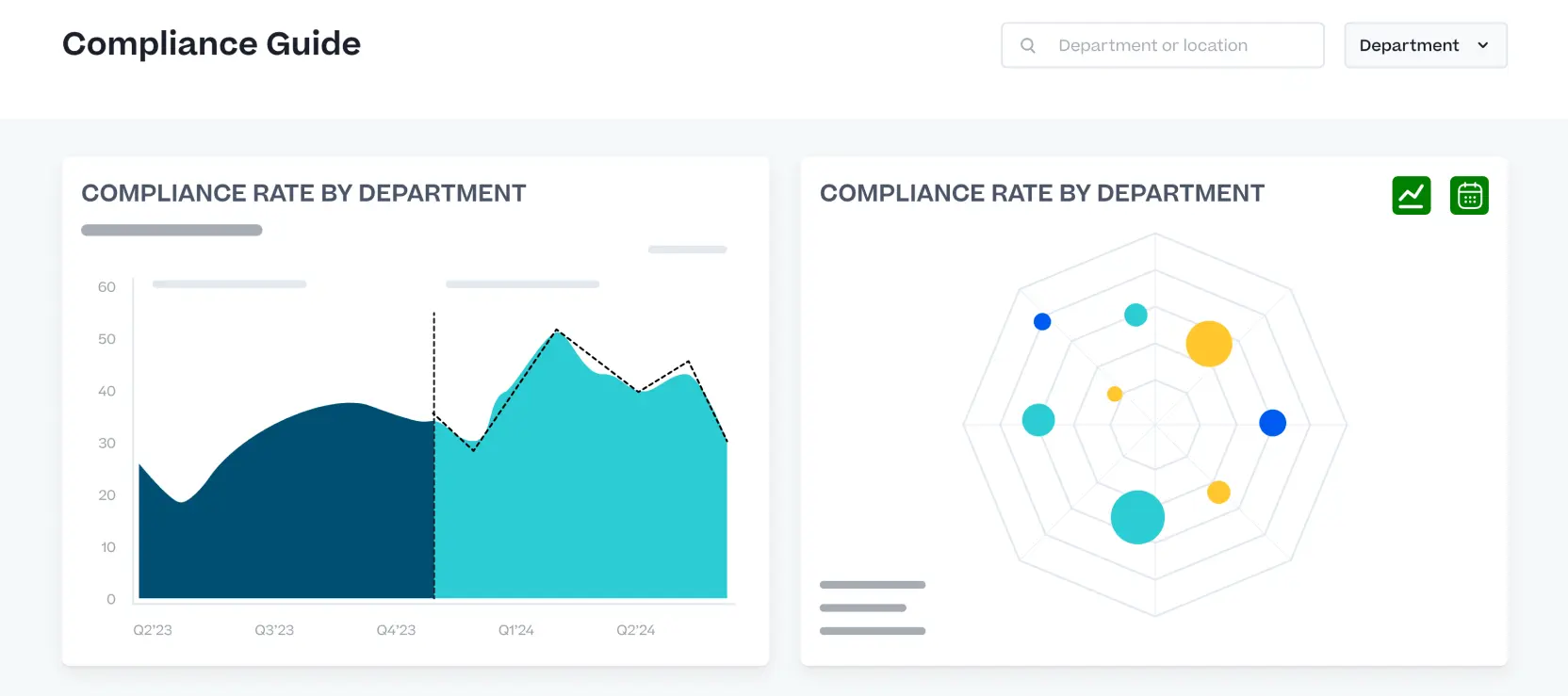
Though we haven’t taken custom eLearning services from them, I got to know from my research that Cornerstone OnDemand helps organizations approach training by allowing for easy customization of Grovo courses or the creation of new, tailored training content.
Cornerstone simplifies compliance management by centralizing training in various formats and providing real-time completion visibility.
It automates certifications, delivers training at the right time, and encourages learning with engaging content. This reduces risk, improves productivity, and increases completion rates.
Cornerstone also offers connected workflows for easier navigation and faster content delivery. Plus, its situational intelligence helps organizations make smarter decisions. These features streamline compliance processes and make them more efficient.
What You Will Like:
- A versatile platform that can be used for various purposes across different industries.
- Strong reporting capabilities that can help track and manage compliance
- Has a large and active user community that provides support, feedback, and best practices
What You May Not Like:
- Many users find the back-end functionalities complex and challenging to navigate
- Lacks the ability to drill down into specific data points for deeper analysis
Pricing:
Custom pricing
4. Docebo – Best for Complex Enterprise Training
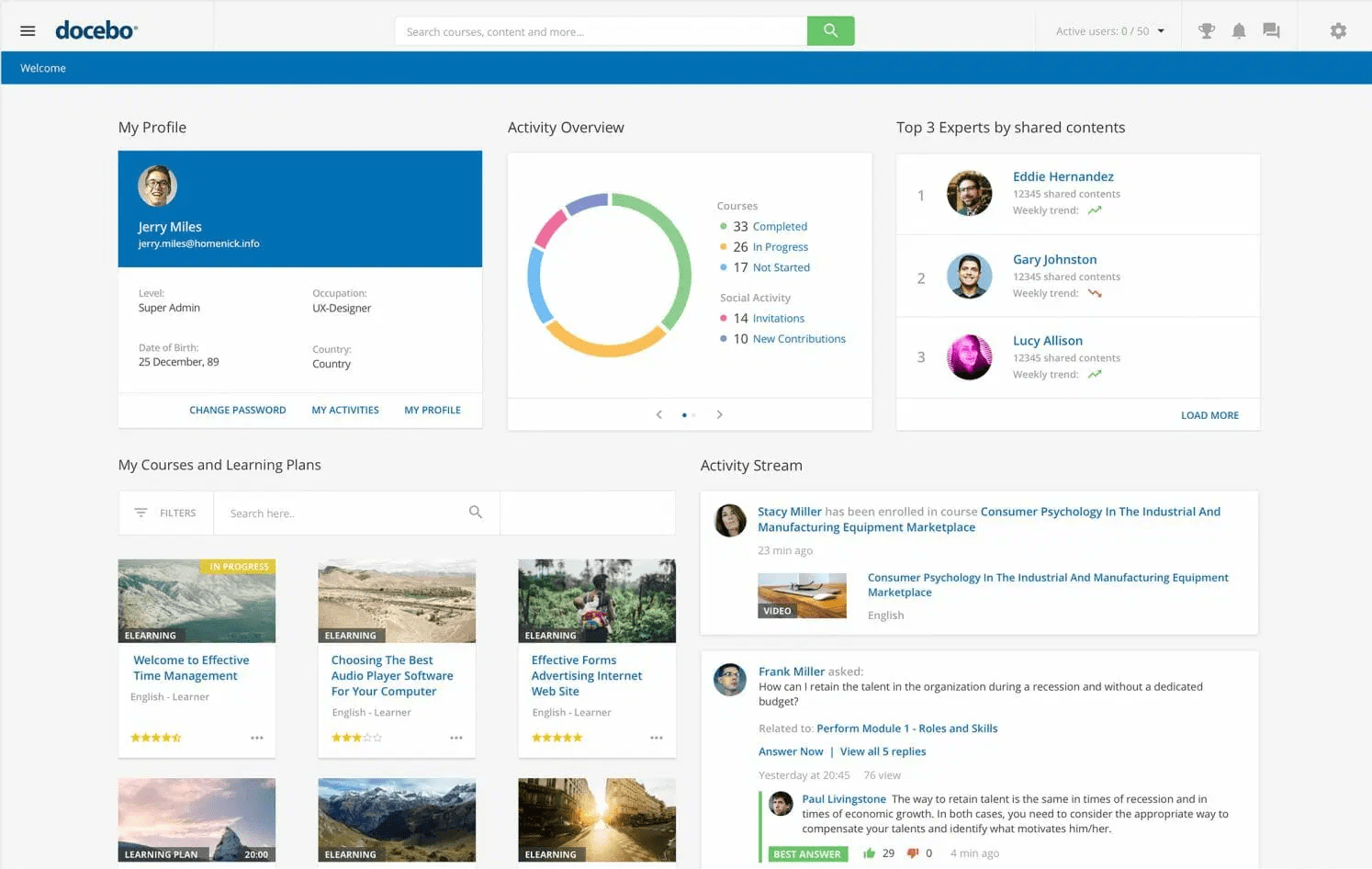
According to the 2019 Gartner CIO Survey, 37% of companies had implemented some type of AI, representing a huge 270% increase over the past four years. (source)
As you can see from the above stat, the use of AI has gone up in the last few years. Keeping this trend in mind, we also tried incorporating AI into our learning journey. That’s when we came across Docebo. While Docebo itself doesn’t directly provide custom eLearning course development services, we tried their AI tool called Docebo Shape, which empowered us to create high-quality eLearning content in minutes.
This AI-powered tool streamlines the content creation process by automatically transforming various sources like internal documents or external knowledge bases into engaging, bite-sized learning modules.
The capabilities extend beyond content creation. It allows for seamless updates, translations, and delivery within your preferred LMS. This empowers businesses to create custom training programs efficiently, making Docebo an attractive option for organizations seeking a comprehensive eLearning solution.
What You Will Like:
- Allows for extensive branding and white labeling
- Integrates with SCORM, xAPI, and SSO
- It can accommodate organizations of all sizes
What You May Not Like:
- The e-commerce module might not be suitable for selling complex online courses
- It may not be ideal for smaller organizations with limited budgets
Pricing:
Custom pricing
5. Tovuti LMS – Best for Learner Experience
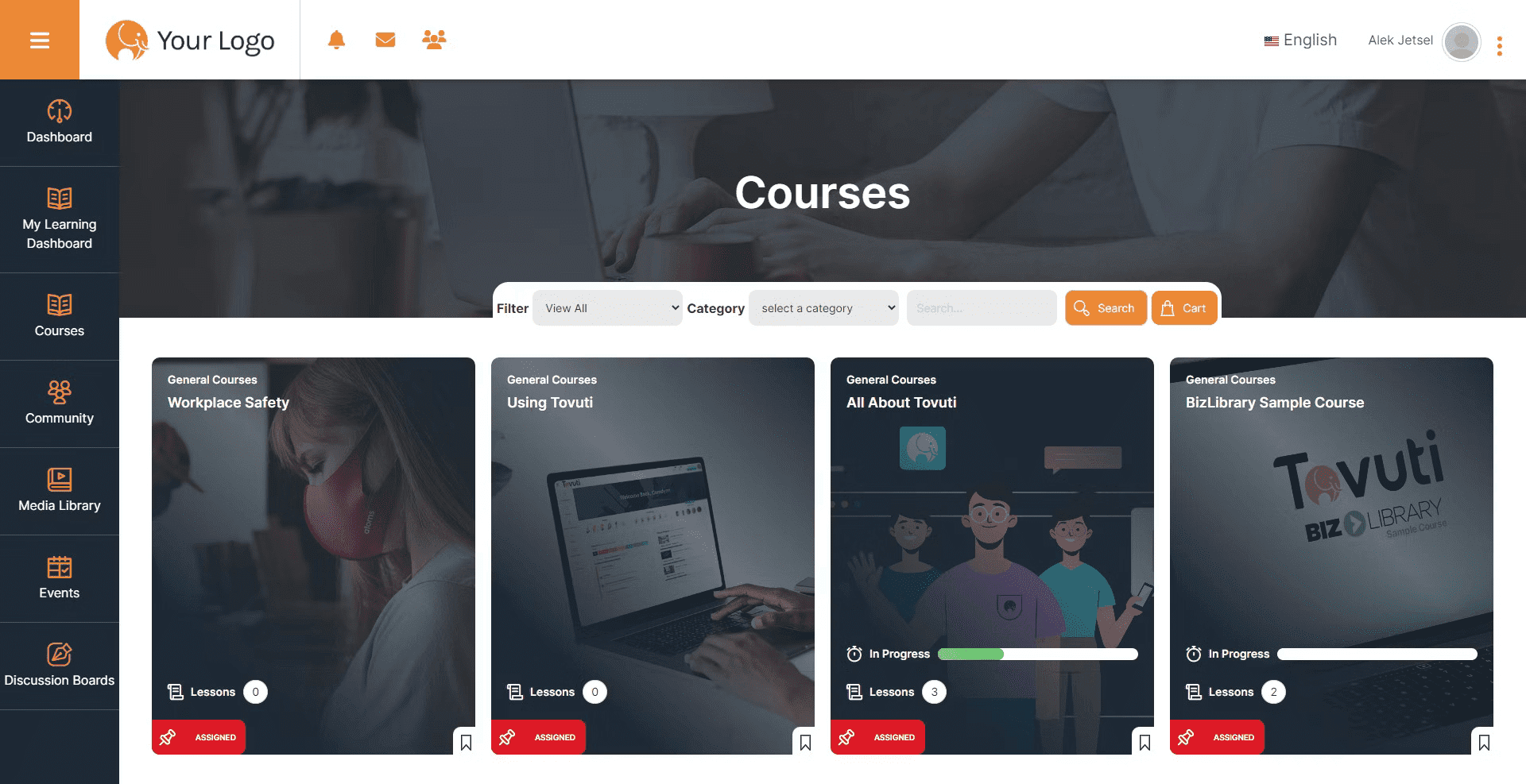
Another tool I would add to this list is Tovuti LMS. Besides offering robust course development features, Tovuti significantly enhances the learning experience. Its intuitive, modern design ensures that lessons are not only sleek but also easy to navigate.
This tool stands out for its 100% mobile responsiveness, which makes learning accessible on any device without the need for a separate app. This platform excels in engaging users through interactive, media-rich content, including multimedia and quizzes that keep learners interested and engaged.
Moreover, Tovuti promotes social and collaborative learning with tools like whiteboards and session recording. Tovuti LMS also supports social profiles and communities.
With built-in video conferencing and language localization, Tovuti caters to a global audience, which makes it easy for us as we have teams spread across multiple locations.
What You Will Like:
- Incorporates gamification elements like badges and points
- Can be deployed in the cloud or on-premise
- Strong reporting capabilities
What You May Not Like:
- Some users find the initial setup to have a steeper learning curve
- Does not offer free demos or trials, which may deter some potential users who want to test the product before buying it
Pricing:
Starts at $11,160. Up to 50 users.
6. Open LMS – Best for Flexible Learning
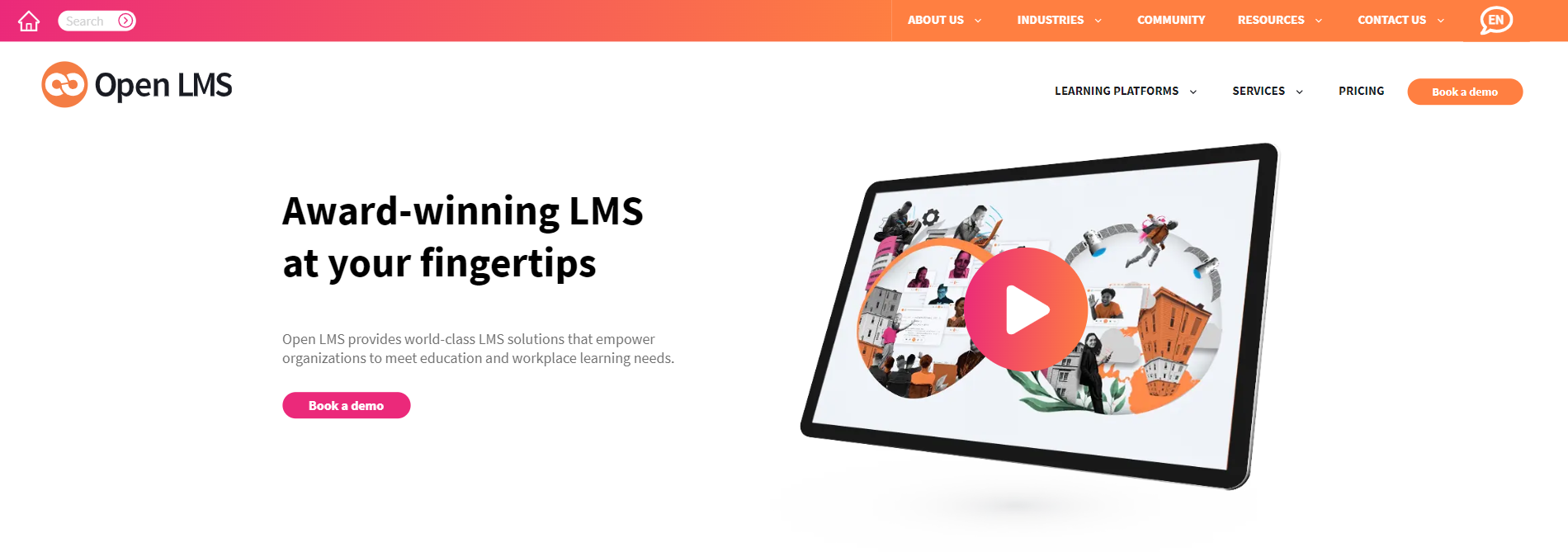
According to a study, 89% of employees want training available anywhere and anytime they need to do their job. This highlights the importance of flexible learning environments in the workplace.
That’s exactly why I recommend Open LMS.
Open LMS Work is a Moodle-based business LMS that provides flexibility in the training industry. It caters to a diverse range of organizational needs with its customizable features. This platform allows for the delegation of user management across different divisions or clients.
It supports unique branding, course catalogs, and dashboards for each tenant, which enhances the user experience. Moreover, Open LMS Work offers powerful reporting capabilities that enable organizations to generate insightful data on shared cohorts or courses.
Its simple to advanced ecommerce options, along with full accessibility compliance, ensure that all users have an equitable learning experience. This level of flexibility makes Open LMS Work an ideal choice for organizations aiming to align their learning strategies with specific business outcomes.
What You Will Like:
- Does not charge any licensing fees, and you can download and install it on your own server
- Gives you the freedom to tailor the platform to your specific requirements and preferences
- Supportive user community that offers ongoing support, advice, and resources
What You May Not Like:
- Requires programming knowledge. You may need to hire a developer or an IT expert
- You may face challenges in connecting Open LMS with your existing CRM or email service
Pricing:
Starts at $1,800 + tax/year. Up to 100 active users. 20GB of storage.
7. iSpring Solutions – Best eLearning software for PowerPoint
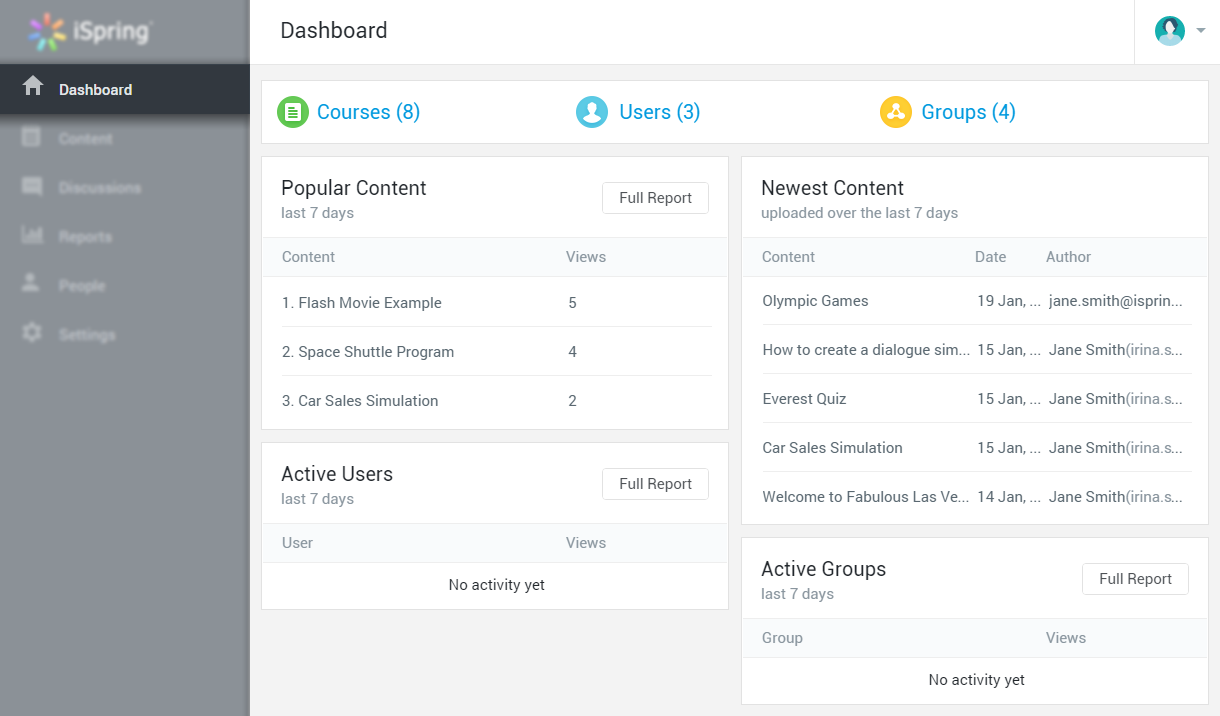
Another tool that deserves mention among the best custom eLearning development platforms is iSpring Learn. Our organization appreciates it for its robust training management features. This tool streamlines the training process, making the assignment of materials straightforward. With just a few clicks, we can enroll employees in courses and learning tracks, setting clear completion rules.
The platform’s handy filter for assigning courses is particularly useful. It allows us to select users by team, job title, country, or other custom parameters. For instance, after uploading a course on warehouse safety, we can easily filter the employee list by job title and quickly enroll all warehouse workers in the course.
iSpring Learn also offers automatic course assignments through which you can auto-assign an onboarding course to every new member of the Interns group. So, it helps a lot to deliver consistent training for all newcomers.
What You Will Like:
- Has a learner portal that lets learners access their courses, view their progress, and communicate with instructors
- Learners can access courses offline and sync their progress when online
- The web meeting feature lets you conduct live sessions with Zoom
What You May Not Like:
- Can be expensive for small businesses
- There are drawbacks in terms of content editing
Pricing:
Starts at $770/author/year. HTML5/SCORM courses.
8. Absorb LMS – Best for Complex Training Needs
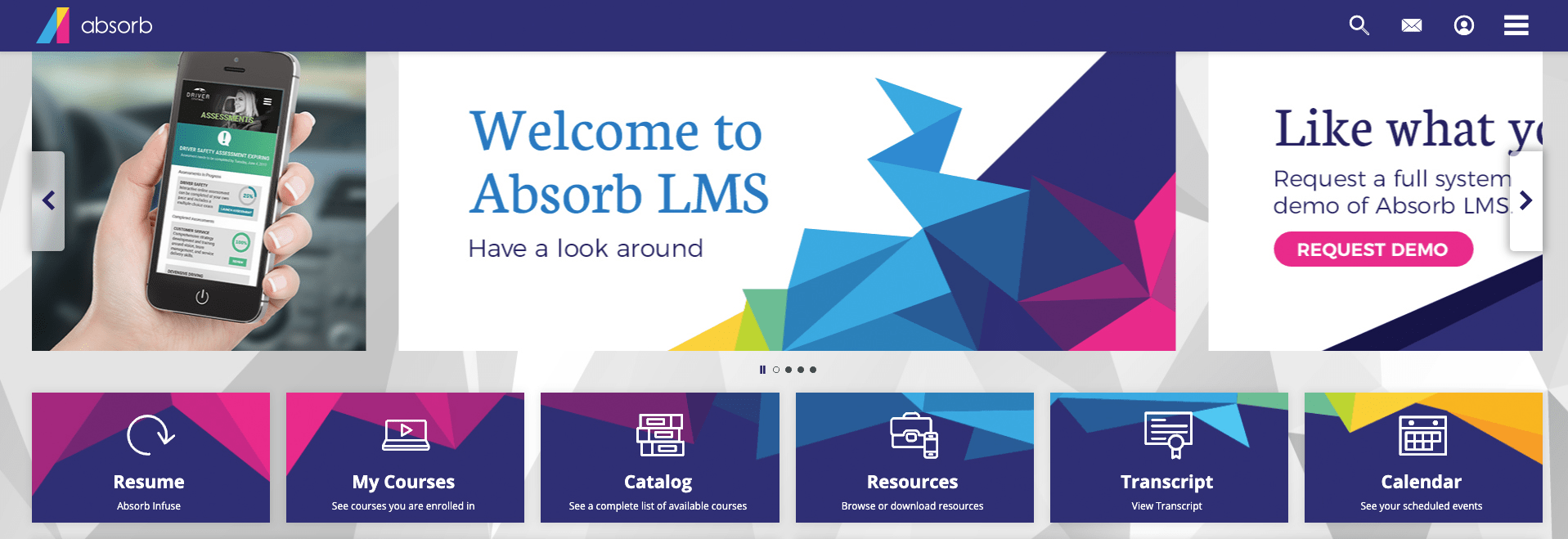
Another tool I would recommend adding to this list is Absorb LMS. It offers a suite of features designed to reduce the administrative burden, which allows teams to concentrate on delivering superior learning experiences.
It empowers administrators by automating routine tasks such as course setup, user management, and advanced reporting. This automation not only saves time but also ensures that your learning initiatives remain on schedule and that your organization complies with relevant standards.
The platform provides easy data access through customizable analytics dashboards. This feature enables administrators to quickly obtain and analyze data to make informed decisions and maintain control over information with a balance of transparency and security.
What You Will Like:
- Offers curated courses from its content libraries that can help you achieve instant ROI
- A learner-centric platform that engages learners with gamification, social learning, and custom certificates
- Allows you to tailor the training to the individual needs and preferences of the learners
What You May Not Like:
- It is relatively expensive compared to other solutions
- Lacks robust project management functions, which may limit its suitability for complex learning scenarios
Pricing:
Custom pricing
9. Elucidat – Best for Experienced Authors
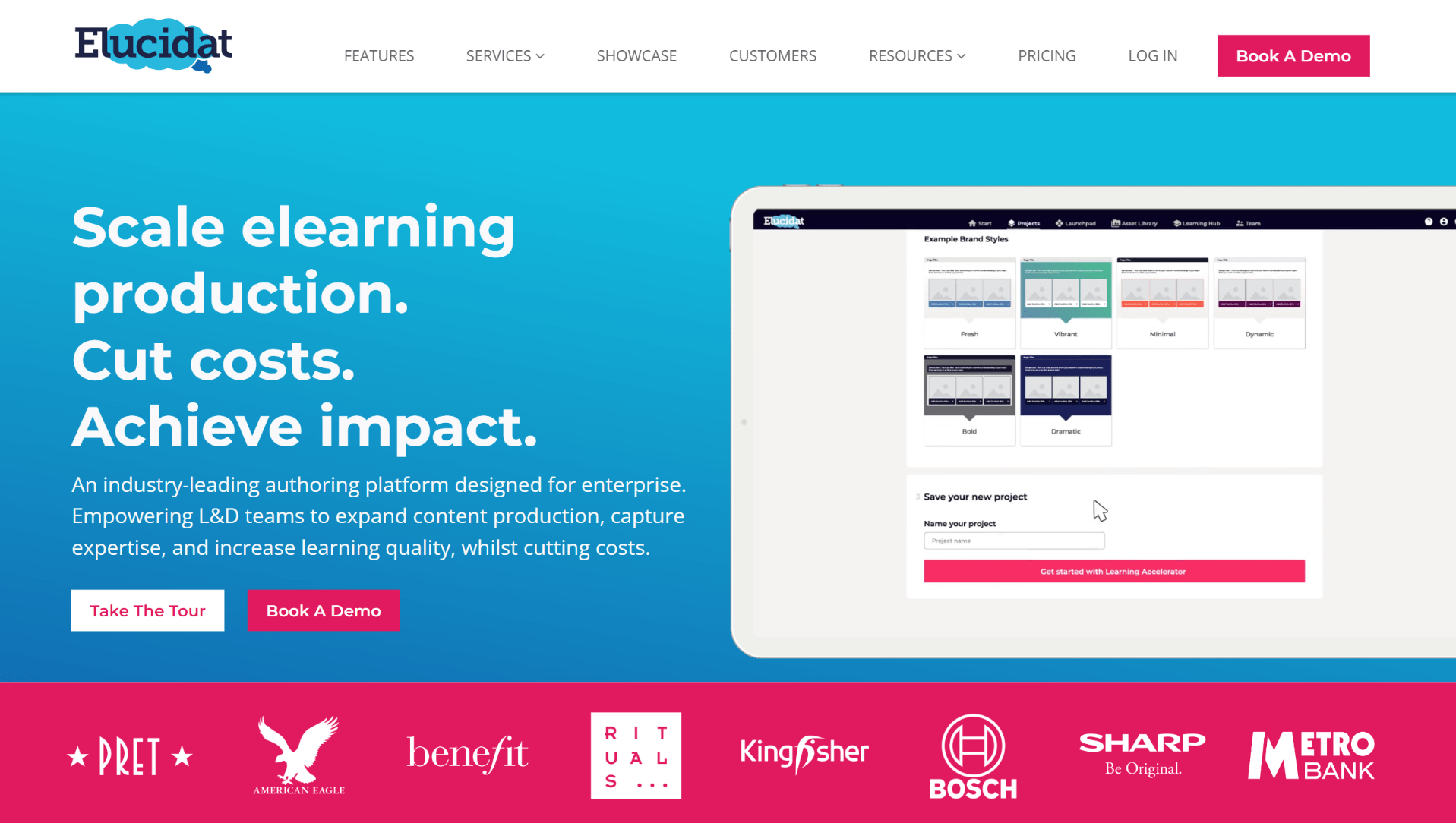
Elucidat is one of the best custom eLearning solutions for experienced authors due to its advanced features. It enables authors to craft highly engaging, tailored elearning experiences efficiently and at scale.
With tools for creating interactive content, such as social polls, branching scenarios, and personalized learning paths, authors can design courses that truly resonate with learners. The platform also simplifies the localization process, making it easier to adapt content for global audiences.
Moreover, Elucidat’s integration with LMS systems and the ability to quickly update and re-release content ensure that elearning programs remain current and impactful. For organizations looking to produce high-quality elearning at a reduced cost, Elucidat’s blend of powerful authoring capabilities and efficient workflows makes it the ideal choice.
What You Will Like:
- Wide range of templates that support SCORM, xAPI, and other formats
- Comprehensive content library that boosts interactive elearning
- Real-time collaboration and workflow functionalities
What You May Not Like:
- Higher cost than some of the competitors
- Limited support for complex branching scenarios and gamification
Pricing:
Custom pricing
10. Thinkific – Best for Coaches Selling Courses
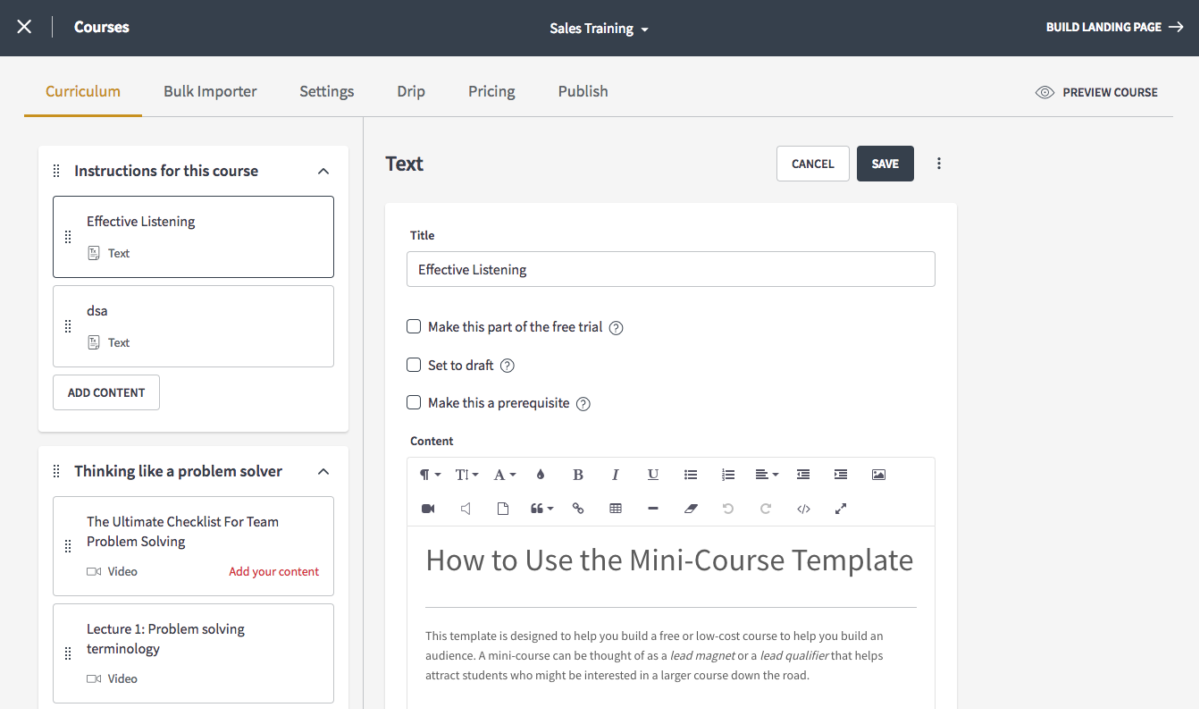
Thinkific emerges as the top platform for selling online courses tailored specifically for those who want to share their expertise and experience. This platform enables impactful and profitable course selling through a user-friendly experience.
Designed with educators in mind, Thinkific appreciates the unique challenges of selling knowledge products compared to physical goods. Thinkific assists in raising awareness for your courses through coupons, promotions, and the ability to reach wider audiences via Groups.
The platform allows the creation of bundles and subscriptions, making your offer irresistible. For sales completion, Thinkific offers tools to create education-focused websites, landing pages, and sales pages that accurately represent your offerings. The optimized checkout process ensures smooth transactions for your students.
What You Will Like:
- Keep learners engaged with subscriptions and communities
- The marketing toolkit lets you focus more on building your learning business and less on mundane tasks
- Powerful selling tools like Order Bumps, Gifting, and Group Orders
What You May Not Like:
- You cannot create multi-format lessons that combine video, text, and audio in one lesson
- Thinkific does not have a sales funnel builder
Pricing:
Starts at $36/month. 1 community. 5 spaces per community
11. 360Learning – Best for Collaborative Learning
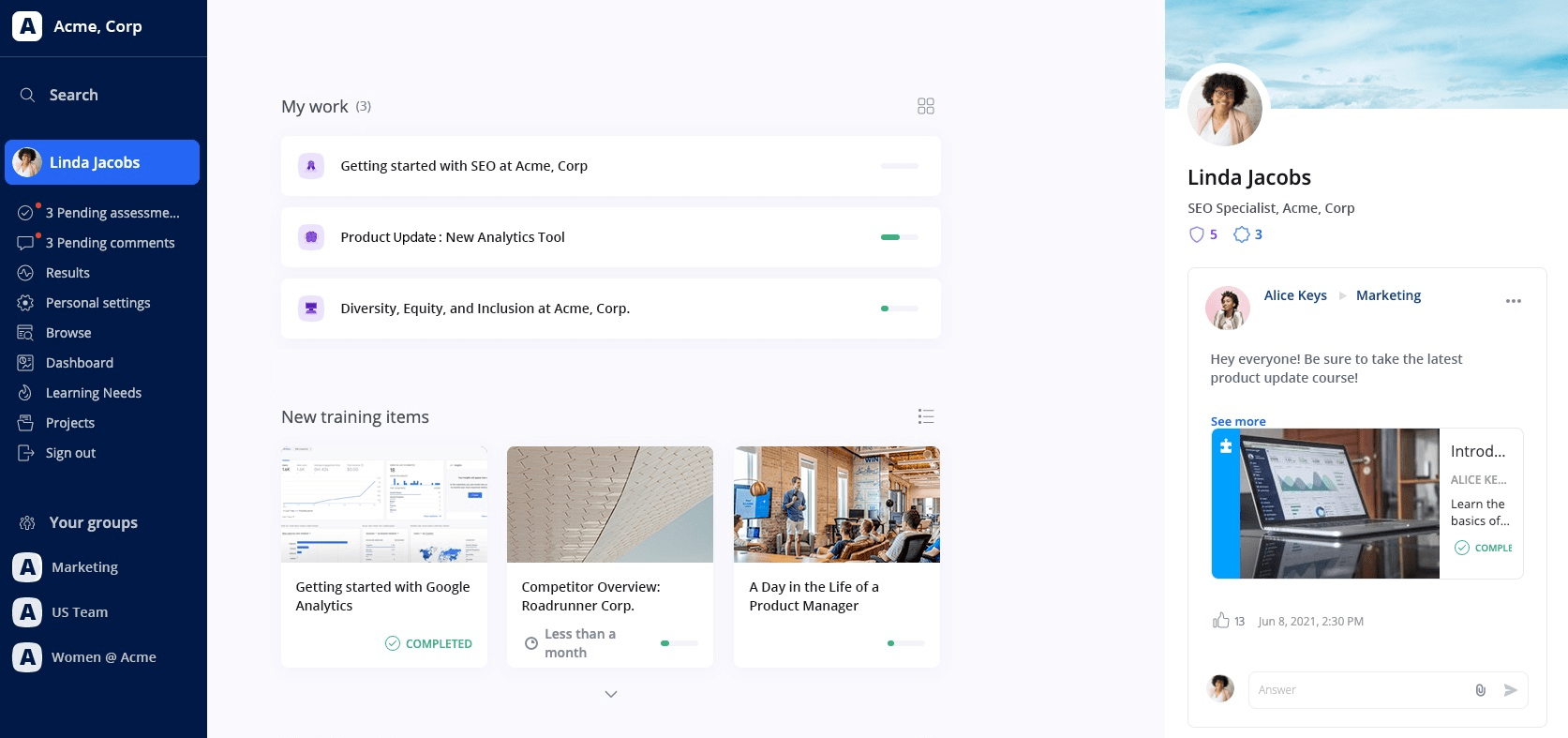
Have you heard of this proverb: “If you want to go fast, go alone. If you want to go far, go together.”
We believe that the strength of each member is the team, and hence, collaborative learning is something we follow.
That’s why we use 360Learning. This platform facilitates a community-driven learning environment. With 360Learning, subject matter experts and learners can contribute, share insights, and provide feedback in real time.
The AI-powered authoring tool in 360Learning, named Robyn, simplifies the content creation process. The ease of course creation and the capability for experts to co-author and iterate on content ensures that our training materials are engaging and effective.
Moreover, 360Learning’s emphasis on collaborative learning extends to its assessment features. The AI-driven question generator creates quizzes directly linked to the course content to help learners understand and retain the material.
What You Will Like:
- Create courses quickly and easily, using various types of content and media
- Offers comprehensive reporting and analytics to measure the impact and effectiveness of learning activities
- It supports multiple languages, domains, and branding options to cater to different markets and audiences
What You May Not Like:
- There are some limitations in terms of course navigation
- You may face issues with searching courses, managing learners, and accessing support
Pricing:
Starts at $8/registered user/month. Up to 100 users/month.
12. LearnDash – Best LMS for WordPress
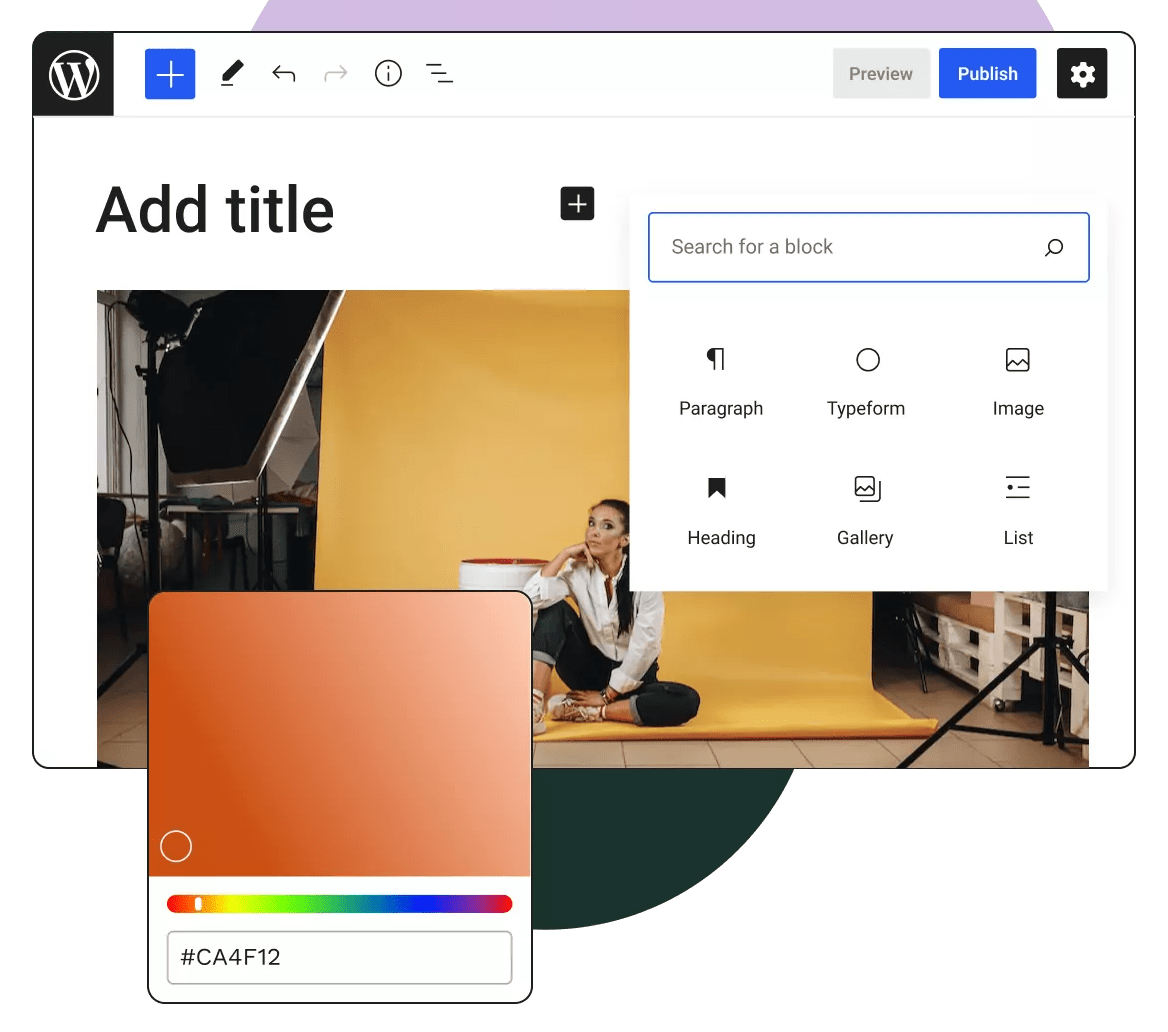
LearnDash LMS for WordPress is a premier course-building tool designed by educators for educators, offering unparalleled control over course creation. This trusted WordPress LMS empowers users to engage learners effectively and increase revenue through its advanced features.
Users can easily manage assignments, approve submissions, award points, and gamify their content for an enhanced learning experience. Collaboration becomes effortless with the ability to organize students into groups. Moreover, LearnDash allows for extensive customization, enabling users to select their preferred theme, use their favorite page builder, and showcase a comprehensive course library.
With its focus on improving learner outcomes through features like Focus Mode and the provision of rewards such as badges and certificates, LearnDash stands out as a powerful solution for creating and managing online courses.
What You Will Like:
- Allows you to set triggers to automate the workflow and access learner metrics and insights
- Compatible with many course authoring tools, media, page builders, and themes
- Has a large community of active users and excellent customer support
What You May Not Like:
- Can be expensive for small startups or individual users
- Lacks built-in marketing strategy to promote your courses
Pricing:
Starts at $199/year. For 1 site. Includes updates and support.
These are some of the best custom eLearning solutions you can try out. Once you choose the tool, your next question will be: how to develop the best eLearning courses?
Even you’re thinking of the same, aren’t you?
In the next section, I will discuss some steps that will assist you in creating the best programs.
How to Develop a Custom eLearning Course: 8 Best Steps
In today’s fast-paced world, attention spans are shorter than ever. This holds true for learners, too.
So, how do you ensure your custom eLearning content cuts through the noise and truly engages your audience?
Here’s a roadmap to help you craft content that sticks:
Step 1: Set Clear Learning Objectives
Before you start with custom eLearning development, you need a blueprint.
Identify your learning goals and objectives – what specific knowledge, skills, or attitudes do you want learners to gain?
Clearly defined objectives act as your guiding star.
Your goals should be SMART (Specific, Measurable, Attainable, Realistic, and Time-Bound). This will help your teams focus on the things that matter most.
Pro Tip: Involve stakeholders in defining objectives. Their insights will ensure the content aligns with organizational goals and resonates with the target audience.
Not sure how to set your SMART goals?
Here’s a short course for you:
Step 2: Understand Your Learners
Who are you creating this eLearning experience for?
Understanding the demographics, learning styles, and prior knowledge of your learner is vital.
This knowledge paves the way for tailoring the content to their specific needs and preferences.
Pro Tip: Conduct learner persona research to gain a deeper understanding of your audience’s characteristics and learning preferences. Conduct a skills gap analysis with assessments to create the right training courses.
Step 3: Choose the Right Instructional Design
Now that you know your destination and your explorers, it’s time to map out the journey.
Instructional design involves selecting the most effective methods to deliver your content. This could include:
- Scenario-based learning: Place learners in realistic situations to apply their knowledge.
- Gamification: Incorporate game elements like points, badges, and leaderboards to boost engagement. Read this guide to gamify your courses.
- Branching scenarios: Provide learners with choices that personalize their learning experience.
- Microlearning: Break down complex topics into bite-sized chunks for easier comprehension and retention. Learning paths offer a structured approach to skill development and ensure a progressive build-up of knowledge.
Pro Tip:Use a variety of instructional methods to cater to different learning styles and keep things interesting. For instance, you can try blended learning. It not only caters to different learning styles but also enables self-paced learning. Try this blended learning software!

Step 4: Make Your Content Engaging
This is where your eLearning experience comes to life!
Develop content that is:
- Visually appealing: Use high-quality images, infographics, and videos to break up text and grab attention. Various studies report that 75% of all information processed by the brain is derived from visual formats.
- Concise and clear: Avoid information overload. Present key points in a well-structured and easy-to-understand manner.
- Interactive: Incorporate quizzes, polls, and simulations to encourage active participation.
Pro Tip: Use storytelling techniques to weave your content into a narrative, making it more relatable and memorable. Use images, podcasts, videos, infographics, case studies, brain games, and PPTs to make your content engaging.
Step 5: Conduct Pilot Testing
One of the major steps in custom elearning course development is pilot testing.
Before unleashing your masterpiece, conduct a pilot test with a small group of representative learners.
This allows you to:
- Gather feedback: Make sure you collect feedback on the content’s clarity, engagement level, and effectiveness in achieving learning objectives.
- Refine the course: Based on the pilot test results, make improvements before wider deployment.
Step 6: Choose the Right Authoring Tool
Now that your content is polished and pilot-tested, it’s time to select an appropriate authoring tool to transform it into a digital learning experience.
Consider factors like:
- Ease of use: How user-friendly is the tool for both developers and learners?
- Features: Does it offer the functionalities you need to create your desired learning experience (e.g., branching scenarios, simulations)?
- Compatibility: Will the output be compatible with your chosen learning management system (LMS)?
Pro Tip: Research and compare different authoring tools to find the one that best suits your project requirements and budget. Watch this video to know more:
Step 7: Share Your Course
It’s time to share your course with your learners. If you use an LMS like ProProfs Training Maker, you can share courses in multiple ways:
- Send email notifications to learners inviting them to the course.
- Generate unique links for each learner and share them directly.
- Import email lists to send course invites to multiple users at once.
- Generate a unique QR code for the course and distribute it for learners to scan and access.
- Embed the course link on your website.
Pro Tip: Ensure the course is readily accessible to your target learners and provide clear instructions on how to access and complete the course. Share certificates or reward them with points and badges after completing a course. This will keep your learners engaged.
Step 8: Collect Feedback
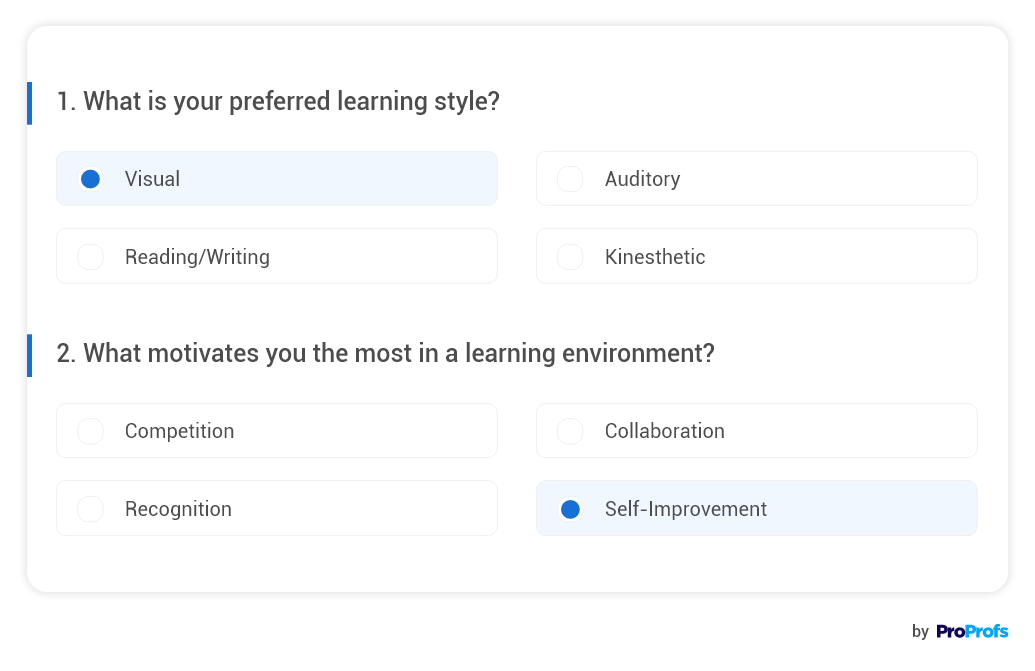
“We all need people who will give us feedback. That’s how we improve.” – Bill Gates.
Learning never stops!
The last step of custom eLearning development is collecting actionable feedback.
Your eLearning journey doesn’t end with just sharing your courses. Gather feedback from learners through surveys and assessments.
Use this data to identify areas for improvement and iterate on your content to ensure its ongoing effectiveness.
Pro Tip: Encourage learners to provide feedback throughout their learning experience after course completion. This allows you to identify potential issues early on and address them promptly. One of the best ways to collect feedback is to use surveys at the end of the training programs.
By following these steps, you can create custom eLearning experiences that educate and captivate your learners and empower them to thrive!
Get Free eLearning Authoring Software — All Features, Forever.
We've helped 567 companies train 200,000+ employees. Create courses in under a minute with our AI LMS or use 200+ ready-made courses on compliance, harassment, DEI, onboarding, and more!
Create the Best Custom eLearning Course with the Right Tool!
A good eLearning course starts with a good tool. It’s not just about making your content look nice but also about connecting with your learners to help them achieve their goals.
The tool you choose can make or break your eLearning project and this is something I’ve witnessed in my career.
That’s why it’s so important to find the right custom eLearning development solutions for your needs.
Once you do, everything else will fall into place. It’s like cooking with fresh and tasty ingredients; you can’t go wrong.
So, how about we focus on finding that ideal eLearning development tool? Trust me, it will make a huge difference for your eLearning courses and your learners’ growth.
So, choose carefully, and you’ll be ready to deliver a learning experience that goes beyond your expectations.
 Tips
Tips
We’d love to hear your tips & suggestions on this article!
Get Free eLearning Authoring Software — All Features, Forever.
We've helped 567 companies train 200,000+ employees. Create courses in under a minute with our AI LMS or use 200+ ready-made courses on compliance, harassment, DEI, onboarding, and more!

 We'd love your feedback!
We'd love your feedback! Thanks for your feedback!
Thanks for your feedback!







